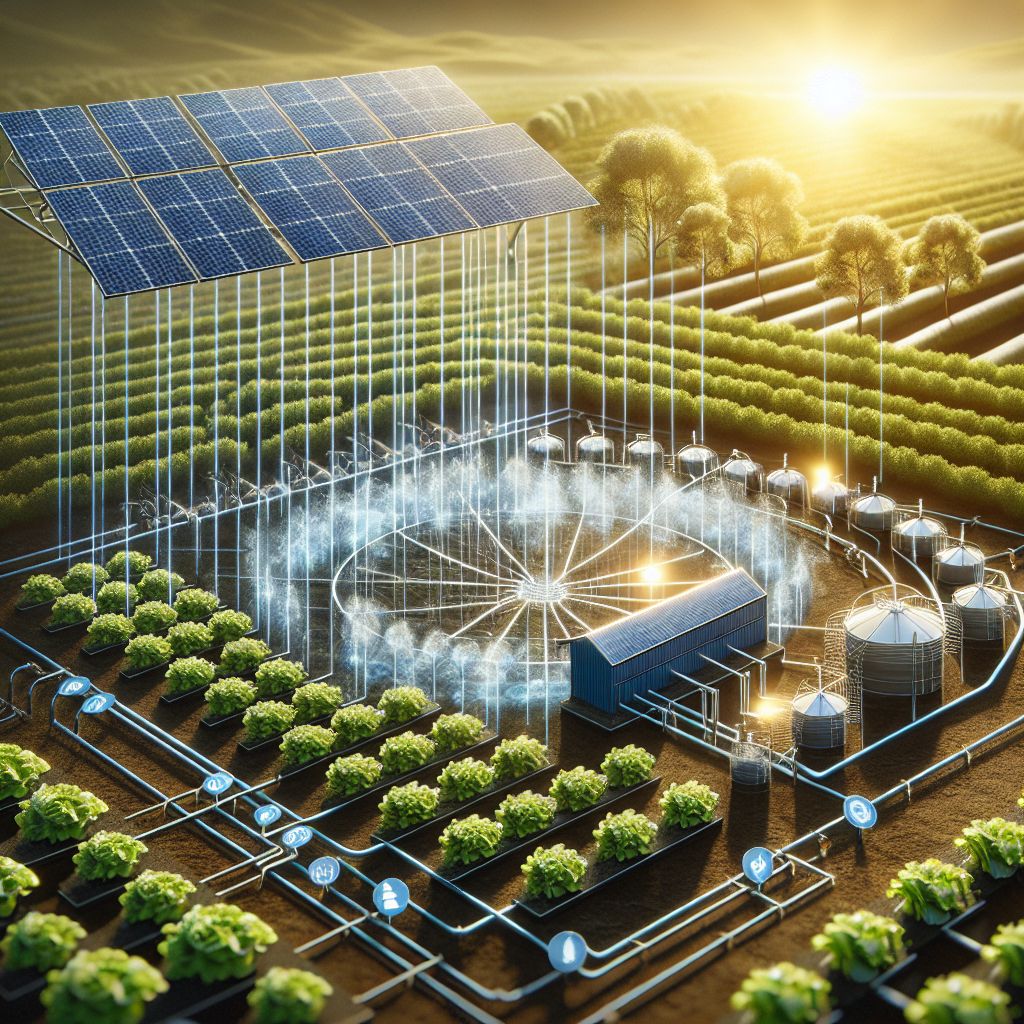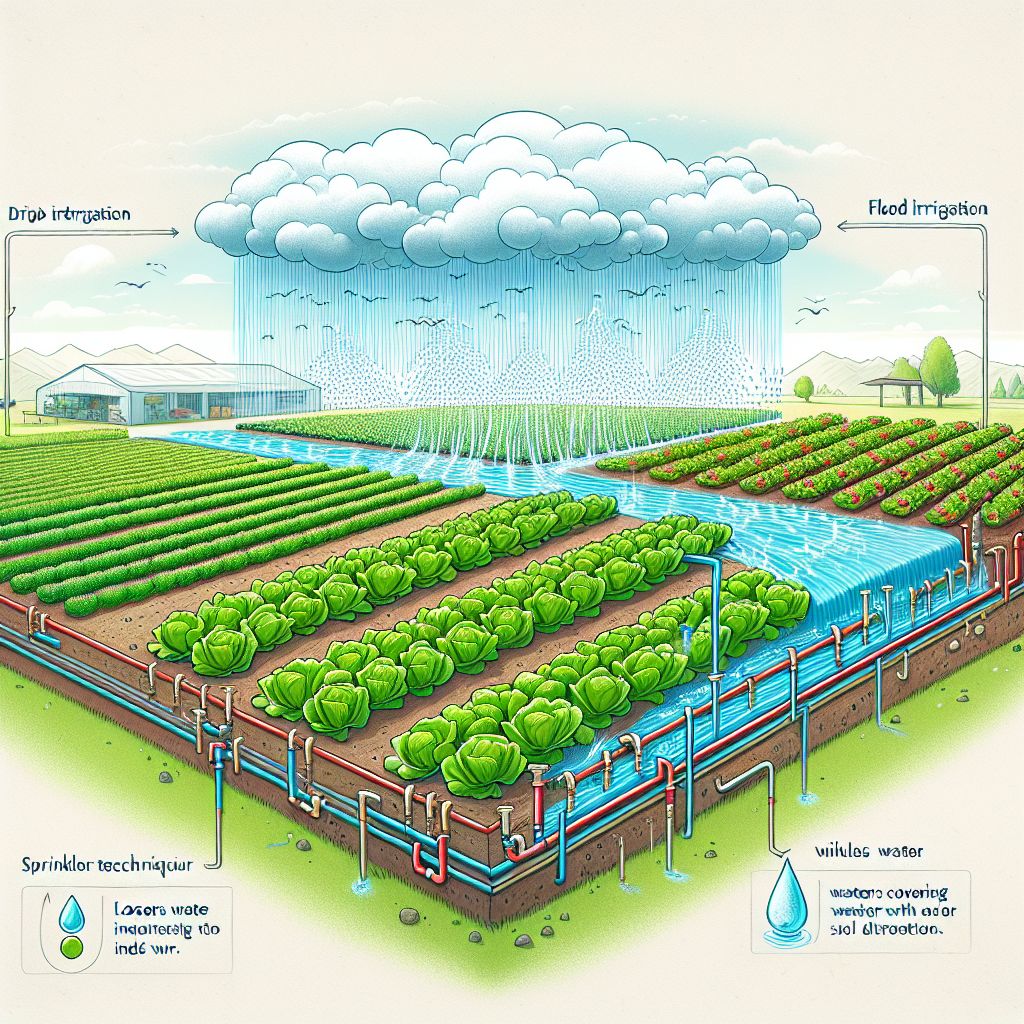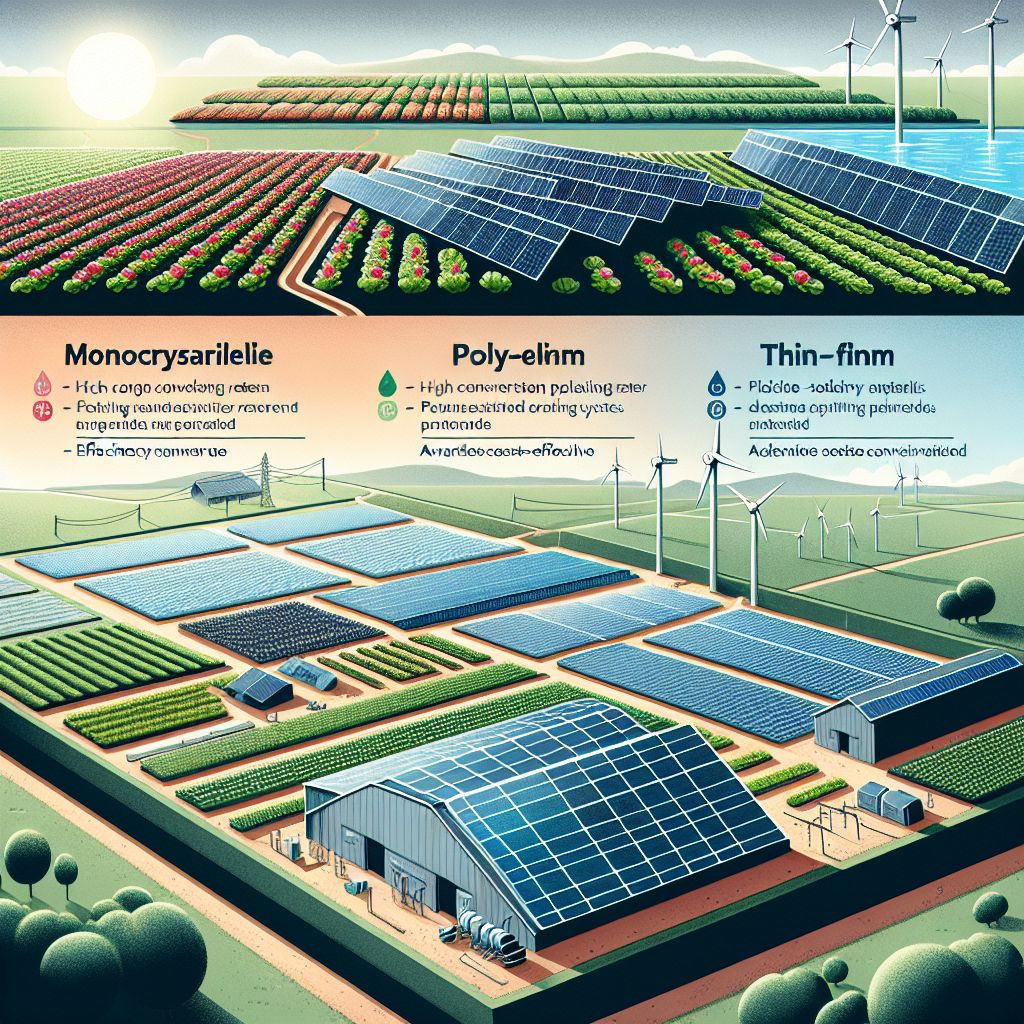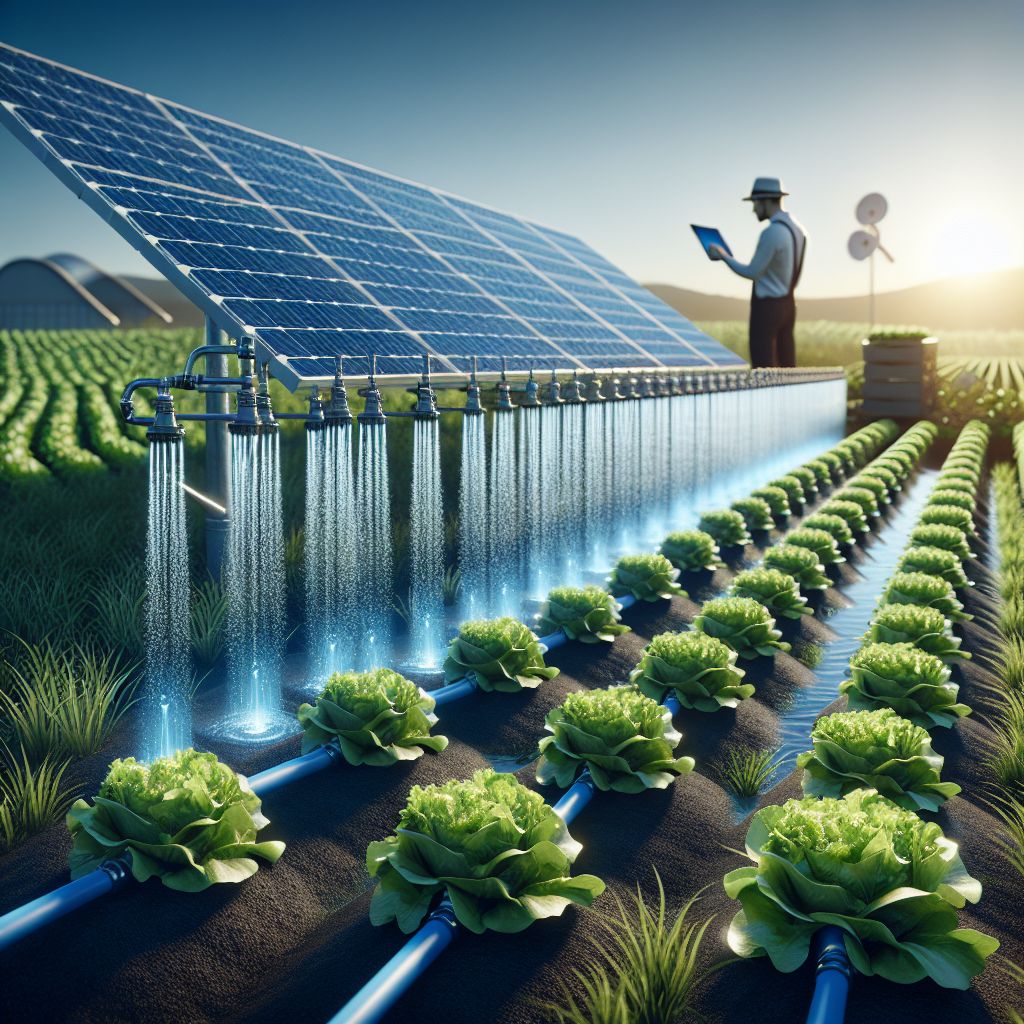
Key Takeaways
Pairing solar panels with irrigation systems can enhance sustainability and decrease expenses.
Drip irrigation is the most water-saving technique for cultivating lettuce.
Monocrystalline solar panels are highly efficient and are ideal for powering agricultural irrigation systems.
Merging solar power with irrigation can result in substantial long-term savings and environmental advantages.
Selecting the appropriate mix of solar panels and irrigation methods is vital for optimizing lettuce production and farm efficiency.
Why Combine Solar Panels with an Irrigation System
Picture a farm where the sun not only encourages lettuce to grow from the ground but also fuels the system that hydrates it. This is not a fantasy; it’s a clever, sustainable approach. Solar panels supply a renewable energy source, which can be utilized to operate irrigation systems, resulting in a smaller carbon footprint and lower energy bills. Above all, this combination promotes a sustainable future for farming.
How Solar Energy and Water Management Work Together
Ever thought about combining solar panels with water pumps? It’s a perfect combination for farmers. Solar panels can harness the sun’s energy and turn it into electricity to run irrigation systems. This cuts down on the use of non-renewable energy and ensures that your lettuce gets watered, even during power outages.
Advantages of Solar-Powered Irrigation for Sustainable Farming
So, what’s in it for you? Solar-powered irrigation systems provide several advantages:
They’re environmentally-friendly, reducing greenhouse gas emissions by eliminating the use of fossil fuels.
These systems are cost-efficient over time, with solar energy being completely free after the initial setup cost.
They offer dependable access to energy, particularly in remote areas where grid connection can be expensive or unfeasible.
Environmental Impact: Saving Resources and Decreasing Carbon Emissions
By tapping into the sun’s energy, farmers are making a positive environmental impact. Solar irrigation systems save water and energy, two resources that are becoming increasingly valuable. And let’s not overlook the decrease in carbon emissions. Each solar panel installed is a move towards a cleaner, more sustainable planet.

Various Irrigation Methods for Lettuce Cultivation on a Farm
Drip Irrigation: A Brief Introduction to Water Efficiency
When it comes to hydrating lettuce, nothing beats drip irrigation. This technique uses a series of pipes to bring water directly to the base of each plant. It’s like providing your lettuce with its own personal beverage, minimizing waste and ensuring each leaf receives exactly what it needs to flourish.
Investigating Sprinkler Systems: Coverage and Factors to Consider
Sprinkler systems are akin to having a rain cloud over your lettuce patch whenever you need it. They are capable of covering large areas and are relatively easy to set up. However, they are not as water-conserving as drip systems. They can also result in water loss due to evaporation and wind drift. Therefore, they are best utilized in certain circumstances where they can be most beneficial.
Furrow and Flood Irrigation: A Classic Approach to Modern Agriculture
Next up, we have furrow and flood irrigation, the tried-and-true veterans of the irrigation world. They’re straightforward and easy on the wallet, but they do tend to use a lot of water. These methods can be effective for lettuce in the right soil conditions, but they need to be managed carefully to avoid waterlogging and soil erosion.
Here is a table summarizing the pros and cons of different irrigation systems for growing lettuce:
|
Irrigation System |
Pros |
Cons |
|---|---|---|
|
Drip Irrigation |
– Efficient water usage, minimizes evaporation and runoff. 1, 3, 4 |
– Initial installation can be expensive. 1, 3 |
|
Sprinkler/Overhead |
– Inexpensive to install. 1, 4 |
– Promotes foliar diseases on pepper plants. 1, 4 |
|
Furrow/Flood |
– Simple system, low installation cost. 1, 3 |
– Very high water usage. 1, 3 |
Now that we know what irrigation system you should use, let’s look at what solar panels you should with your farms irrigation system.

Different Solar Panels You Can Add to the Irrigation System to Grow Lettuce on a Farm
When considering solar panels for an irrigation system to grow lettuce on a farm, several types of solar panels can be evaluated based on their efficiency, cost, durability, and suitability for the farm’s specific conditions. Here are the main types of solar panels you can consider.
Monocrystalline Panels: The Efficient Choice for Lettuce Farming
When it comes to efficiency, farmers turn to monocrystalline solar panels. These panels have a high conversion rate, which means they excel at converting sunlight into electricity, even on overcast days. This is crucial when you depend on the sun to power your irrigation system and keep your lettuce vibrant.
Affordable Irrigation with Polycrystalline Panels
Another option is polycrystalline solar panels. They may not be as efficient as monocrystalline panels, but they are more cost-effective. For lettuce farmers who are budget-conscious, these panels provide a more economical way to implement solar-powered irrigation without significantly sacrificing performance.
Thin-Film Solar Panels: Versatile Setup Choices
It’s also worth mentioning thin-film solar panels. These are the latest addition to the solar panel family, offering actual flexibility. They can be unrolled like a rug over vast spaces and are less impacted by high temperatures. For a farm with a lot of space, thin-film could supply a constant stream of power for your irrigation needs.
Right below is a table looking at all the different solar panel options:
|
Solar Panel Type |
Efficiency Range |
Advantages |
Disadvantages |
|---|---|---|---|
|
Monocrystalline |
17-22% |
Highest efficiency, space-saving, long lifespan. 2 | |
|
Polycrystalline |
15-17% |
Lower efficiency, requires more space. 2 | |
|
Thin-Film |
10-13% |
Lightweight, flexible, good temperature coefficient. 2 |
Lowest efficiency, requires large area. 2 |
Monocrystalline panels provide the highest efficiency in a compact area but at a higher upfront cost (2, 3). Polycrystalline panels offer a balance of efficiency and cost (2, 3). Thin-film panels have lower efficiency but perform better in high temperatures (2). The optimal choice depends on factors like available space, budget, local climate conditions, and specific irrigation requirements for growing lettuce.
What Solar Panel Should I Use for Growing Lettuce?
Which panel is best for your lettuce depends on your individual needs. If you want the best efficiency and can afford it, monocrystalline panels are the way to go. Polycrystalline panels are a good compromise. And if you need something lightweight and flexible, thin-film panels are the perfect choice.
Combining Solar Panel Systems with Current Irrigation Infrastructure
It’s easier than you may think to incorporate solar panels into your current irrigation system. Begin by evaluating your energy requirements and align your solar panel output with those needs. The goal is to create a smooth transition from sunlight to water pump, making sure your lettuce plants are always hydrated.

Comparing the Costs and Efficiency of Solar and Traditional Irrigation Systems in Lettuce Cultivation
Let’s get down to brass tacks. It’s true that solar irrigation systems have a higher initial cost than traditional ones. But over time, they can save you a significant amount of money. No more electric bills for pumping water, for one thing. Plus, solar technology is becoming more affordable every year, making it easier than ever to switch.
Understanding the Investment: Initial Costs and Ongoing Savings
While it’s true that the upfront cost of a solar irrigation system can be substantial, it’s important to remember that the energy savings begin immediately. Over time, these savings can not only offset the cost of the system, but can even result in additional savings. Think of it like planting a seed for your future financial stability – a little patience now can yield a significant return later.
Contrasting Water and Energy Efficiency
When you put solar irrigation and conventional systems side by side, the benefits of solar irrigation become apparent. Solar irrigation, especially when paired with drip systems, can be as much as 90% efficient in water use. Conventional systems, on the other hand, are notorious for their wastefulness. They can squander significant amounts of water and energy, which is bad for both the environment and your wallet.
Does Solar Irrigation Make Financial Sense?
By converting to solar irrigation, a lettuce farm can decrease water and energy expenses by up to 30%, which can significantly increase profit margins.
It’s not just about being environmentally conscious; it’s also about the money you can save. By lowering operating expenses, solar irrigation can increase your profit margins. Plus, with the growing demand for sustainable produce, your solar-powered lettuce might even fetch a higher price.
This table compare the pros and cons of solar-powered irrigation systems and conventional irrigation systems:
|
Aspect |
Conventional Irrigation System |
Solar-Powered Irrigation System |
|---|---|---|
|
Pros |
No ongoing energy costs, uses free solar power. 5 | |
|
Simple installation and maintenance. 1 |
Environmentally friendly, reduces carbon footprint. 3 | |
|
Reliable water supply even during power outages. 5 | ||
|
Long lifespan of solar panels (25-30 years). 5 | ||
|
Cons | ||
|
Susceptible to power outages. 5 |
Requires some technical knowledge for installation/maintenance. 3, 4 | |
|
Environmental impact from energy use. 3 |
Risk of over-abstraction of groundwater if not managed properly. 3, 4 | |
|
Potential for water waste/inefficiency. 1 |

Which is the Most Efficient Match of Solar Panels and Irrigation Systems for a Lettuce Farmer
Choosing the most efficient combination of solar panels and irrigation systems for your lettuce farm is like a matchmaker’s job. The goal is to find a pair that works together well to maximize efficiency and yield. It’s a balancing act between cost, efficiency, and the specific needs of your crop and climate.
Case Studies: Successful Solar Irrigation Implementations on Lettuce Farms
Take the example of GreenLeaf Farms in California. They switched to solar-powered drip irrigation and saw a 25% increase in their lettuce yield while cutting irrigation costs by half. Their success lies in the precise application of water, ensuring that each plant receives just what it needs without wastage.
Take Sunny Acres in Arizona for example. The harsh sun was more of a hindrance than a help – until they implemented solar panels. Now, they use the sun for two things: growing their lettuce and powering the pumps that irrigate them. They’ve lessened their carbon emissions and have become a standard for eco-friendly farming in their area.
Creating a Custom Setup: Finding the Perfect Match
Identifying the perfect match for your farm begins with an energy audit. How much power is required to run your irrigation system? Then, evaluate your water usage. How much water does your lettuce crop need, and when does it need it? With this information, you can choose a solar panel system that fulfills your energy requirements and an irrigation technique that aligns with your water needs.
Many find that using monocrystalline solar panels in conjunction with a drip irrigation system is the best way to achieve a balance between cost and efficiency. The panels are a dependable source of power, while the drip system ensures the water goes right to the lettuce’s roots, reducing both evaporation and runoff.
Conclusion:
In conclusion, combining solar panels with irrigation methods is not only an intelligent farming strategy, but it also paves the way for a more sustainable and lucrative future. By using solar power to irrigate your lettuce fields, you are lessening your ecological footprint, saving money, and guaranteeing a bountiful, verdant yield. The future of agriculture is promising, and it’s solar-powered.
Frequently Asked Questions (FAQ)
Can I Use a Solar Irrigation System if I Don’t Get Much Sun?
Yes, solar irrigation systems can still work in areas that don’t get a lot of sun. While the system may not be as efficient, today’s solar panels can still generate power even when it’s not very sunny. Plus, if you have a battery storage system, you can save the extra power generated on sunny days for use when it’s cloudy.
What Kind of Upkeep Do Solar-Powered Irrigation Systems Need?
Solar-powered irrigation systems don’t need much maintenance. To keep them running efficiently, it’s a good idea to clean the solar panels regularly to get rid of dust and debris. You should also check the irrigation lines to make sure they’re not leaking or blocked.
Keep in mind, a well-kept solar irrigation system not only has a longer lifespan but also works more efficiently, saving you more money and water over time.
How Soon Can a Solar Irrigation System Recoup Its Cost?
The period it takes for a solar irrigation system to recoup its cost can vary depending on several factors, such as the size of the system, the price of electricity in your area, and the amount of sunlight available. However, with the decreasing price of solar technology and increasing energy costs, many farmers find that their systems recoup their costs within 3 to 5 years.
Are there any government incentives for using solar power in farming?
Yes, there are often federal and state incentives, such as tax credits, rebates, and grants, available for farmers who use solar power.
Programs like the USDA’s Rural Energy for America Program (REAP) can provide financial help.
Always check with local authorities and energy departments for the most up-to-date information and eligibility requirements.
What types of lettuce are best suited for solar-powered irrigation?
All types of lettuce can benefit from solar-powered irrigation, but the efficiency of the system may be especially good for varieties that need consistent moisture, such as romaine and butterhead lettuces. The precise water delivery of drip systems can also be good for delicate varieties that are prone to disease if overwatered.







Leave a Reply